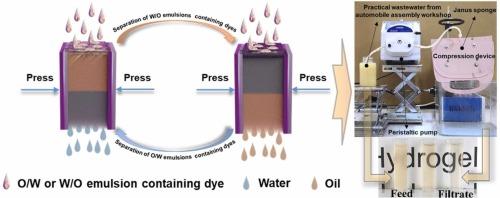3D Janus sponge with controllable pore size for stable separation of oil-water emulsion and dye contaminants
IF 12.2
1区 环境科学与生态学
Q1 ENGINEERING, ENVIRONMENTAL
引用次数: 0
Abstract
The development of separation materials with high flux, anti-oil fouling, long-term stability, and the ability to remove various pollutants is an urgent requirement in the field of oil-water separation. Herein, we designed a Janus sponge with multiple separation functions. Specifically, we first prepared the PCA-CS gel coating on the polyurethane (PU) sponge through the co-deposition of protocatechuic acid (PCA) and chitosan (CS), and then Janus sponge was obtained through bottom-up approach of adsorbing stearic acid (SA) and an ethanol suspension of titanium dioxide (TiO2). The prepared Janus sponge exhibits excellent wetting behavior and oil adhesion resistance, and can maintain stable performance in acidic, alkaline, saline solutions and ultrasonic environment. The pore size of the Janus sponge can be adjusted by mechanical compression to efficiently separate various types of emulsions, dyes and mixed wastewater. Among them, the emulsion and dye separation efficiency can both be above 99.6%, and can maintain the high flux with 15372.7 L m-2 h-1. More importantly, the prepared Janus sponge can effectively remove the emulsified oil droplets from the wastewater generated by the automotive final assembly shop. Consequently, it can be predicted that Janus sponge exhibits great application potential in emulsion and dye wastewater treatment.

求助全文
约1分钟内获得全文
求助全文
来源期刊

Journal of Hazardous Materials
工程技术-工程:环境
CiteScore
25.40
自引率
5.90%
发文量
3059
审稿时长
58 days
期刊介绍:
The Journal of Hazardous Materials serves as a global platform for promoting cutting-edge research in the field of Environmental Science and Engineering. Our publication features a wide range of articles, including full-length research papers, review articles, and perspectives, with the aim of enhancing our understanding of the dangers and risks associated with various materials concerning public health and the environment. It is important to note that the term "environmental contaminants" refers specifically to substances that pose hazardous effects through contamination, while excluding those that do not have such impacts on the environment or human health. Moreover, we emphasize the distinction between wastes and hazardous materials in order to provide further clarity on the scope of the journal. We have a keen interest in exploring specific compounds and microbial agents that have adverse effects on the environment.
 求助内容:
求助内容: 应助结果提醒方式:
应助结果提醒方式:


